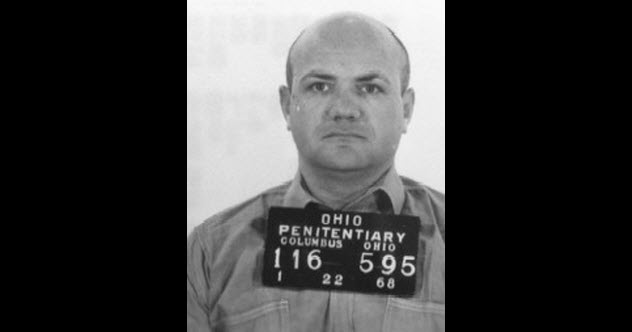 Miscellaneous
Miscellaneous  Miscellaneous
Miscellaneous  Animals
Animals 10 Strange Attempts to Smuggle Animals
 Travel
Travel 10 Natural Rock Formations That Will Make You Do a Double Take
 Movies and TV
Movies and TV 10 Actors Hidden in Your Favorite Movies
 Our World
Our World 10 Science Facts That Will Change How You Look at the World
 Pop Culture
Pop Culture 10 Incredible Female Comic Book Artists
 Crime
Crime 10 Terrifying Serial Killers from Centuries Ago
 Technology
Technology 10 Hilariously Over-Engineered Solutions to Simple Problems
 Miscellaneous
Miscellaneous 10 Ironic News Stories Straight out of an Alanis Morissette Song
 Politics
Politics 10 Lesser-Known Far-Right Groups of the 21st Century
 Miscellaneous
Miscellaneous 10 Undeniable Signs That People’s Views of Mushrooms Are Changing
 Animals
Animals 10 Strange Attempts to Smuggle Animals
 Travel
Travel 10 Natural Rock Formations That Will Make You Do a Double Take
Who's Behind Listverse?

Jamie Frater
Head Editor
Jamie founded Listverse due to an insatiable desire to share fascinating, obscure, and bizarre facts. He has been a guest speaker on numerous national radio and television stations and is a five time published author.
More About Us Movies and TV
Movies and TV 10 Actors Hidden in Your Favorite Movies
 Our World
Our World 10 Science Facts That Will Change How You Look at the World
 Pop Culture
Pop Culture 10 Incredible Female Comic Book Artists
 Crime
Crime 10 Terrifying Serial Killers from Centuries Ago
 Technology
Technology 10 Hilariously Over-Engineered Solutions to Simple Problems
 Miscellaneous
Miscellaneous 10 Ironic News Stories Straight out of an Alanis Morissette Song
 Politics
Politics 10 Lesser-Known Far-Right Groups of the 21st Century
10 Murderous College Professors
College professors are some of the most revered members of polite society. Most are well-educated, respectful intellectuals who are occasionally guilty of thinking that advanced degrees make them better than the average Joe or capable of talking like an expert on almost anything. However, a minority of college professors are guilty of a much graver sin—murder—which proves that education can’t always protect us from the darker human impulses.
10Gene Isaac Stees

Athens, Ohio—which is home to Ohio University—is not only one of America’s most beautiful college towns but also one of its most infamous. Almost every inch of the town is reportedly haunted. Some people point out that the town’s cemetery fits neatly inside of a pentagram, suggesting that the town is just plain evil.
In fall 1962, no ghosts were necessary. Professor Gene Isaac Stees was plenty evil enough for Athens. Stees, 31, was an assistant professor at Ohio University and a married man with two children. However, his marriage to his 30-year-old wife, Helen, was anything but blissful. The two fought constantly because Professor Stees was having an extramarital affair.
Things came to a head on October 20, 1962, when Helen, who was then living with her parents in Ashland, Ohio, agreed to meet Stees in Athens. During a supposed attempt at reconciliation, Stees hit his wife over the head with a crowbar and then pulled a plastic bag over her head to cut off her breathing. Once Helen was dead, Stees put her corpse in a metal drum and dropped it in the middle of Dow Lake.
It didn’t take police long to find Professor Stees. After investigators discovered blood in his car, the professor-turned-murderer confessed to the killing. He had two motives: He wanted to marry his mistress, and he was upset that his wife was pregnant again.
In February 1963, a jury convicted Stees of murder but recommended mercy, thus bypassing the death penalty in favor of life imprisonment. Some jurors may regret that decision because Stees escaped from the Ohio Penitentiary in Columbus on February 21, 1970. He is listed as missing and is considered one of the “Most Wanted” criminals in the Buckeye State.
9George Zinkhan

Since Athens was the seat of learning in ancient Greece, the name has become a byword for learning and knowledge. Athens, Georgia—which the University of Georgia (UGA) has called home since 1785—is no different, although the town is actually more known for its independent rock scene than anything else.
In 2009, something other than great music made Athens well-known. On April 25, outside a theater in downtown Athens, 57-year-old George Zinkhan, a professor of marketing at UGA and a published poet, shot and killed three people. The victims—Tom Tanner, Ben Teague, and Zinkhan’s wife, Marie Bruce—were killed in public with multiple eyewitnesses. Zinkhan’s motive was not clear, although there were rumors that his marriage was in trouble. Others have pointed out that Zinkhan may have felt persecuted or suffered from an inflated ego and sense of pride that led him to commit the murders.
Regardless, Zinkhan decided to commit suicide rather than run or face charges for premeditated murder. After finding his red Jeep Liberty in Clarke County, officers with cadaver dogs discovered that Zinkhan had dug his own grave and gone to great lengths to conceal his body before finally shooting himself in the head.
8Eric Muenter

A professor of his native German language at Harvard, Eric Muenter was also fascinated by insanity and criminality. He collected news clippings and articles about criminology obsessively. He was also known as a tireless, sometimes overzealous worker.
Not long after getting a teaching position at Harvard, Muenter and his wife, Leone, celebrated the birth of their second child. Unfortunately, Leone’s health declined quickly after that. When she died 10 days after giving birth, Muenter rushed to give his wife a burial. He wouldn’t allow an autopsy but instead sent examiners in Massachusetts her stomach and intestines. From there, Muenter boarded a train for Chicago and made a getaway.
Authorities soon discovered that he had poisoned his wife with arsenic. After skipping town, Muenter traveled to Texas, where he changed his name to “Frank Holt” and began studying again for a college degree. Eventually, he became a professor of German at Cornell.
At the outset of World War I, another side of his warped personality emerged. An ardent German nationalist and accomplished bomb maker, Muenter plotted against America because of its pro-British leanings. On July 2, 1915, a bomb planted by Muenter went off in an empty reception area at the US Capitol. Although the bomb didn’t cause any casualties, the explosion frightened many in the American reading public.
Muenter was not finished, however. Within a week, he placed a time bomb aboard the SS Minnehana and a bomb at NYPD headquarters. His final act came when he tried to assassinate the great financier J.P. Morgan at his home on Long Island. After forcing his way into the house, Muenter managed to shoot Morgan twice but Morgan’s butler stopped Muenter from killing one of America’s richest men.
7Norma Patricia Esparza
In 1995, Norma Patricia Esparza, then a college student at Claremont, was supposedly raped by Gonzalo Ramirez, a man whom she had met at a bar. Not long afterward, Ramirez was involved in a car accident that turned into a lethal attack. Three men, including Esparza’s ex-boyfriend Gianni Van, kidnapped Ramirez before butchering him to death with meat cleavers. His body was ultimately dumped in the nearby city of Irvine, California.
For years, Esparza, who had become a psychology professor, was seen as a potential perpetrator by detectives involved in the case. Others believed that she was being unfairly targeted. Many advocates for rape victims came to her defense.
In 2014, Esparza finally admitted in court that she had conspired to have Ramirez killed. Esparza had taken Van to a bar in Santa Ana to finger Ramirez as the man who had raped her in her dorm room. Incensed, Van recruited others to kill Ramirez in revenge.
According to Esparza, her post-rape depression and fear led her to unwillingly cooperate with Van, but many claim that she was the mastermind behind the entire attack. A California court gave her six years in prison for her role in the murder.
6Ernesto Bustamante
Popular among both undergraduate and graduate psychology students at the University of Idaho, Professor Ernesto Bustamante was known simply as “E” to many. Kathryn Benoit, who enjoyed Professor Bustamante’s company like so many others, soon went beyond mere admiration. Benoit joined Bustamante at a research laboratory and then made him her graduate adviser. Before long, the two were romantically involved.
The relationship went sour soon afterward. At some point, Benoit filed a sexual harassment complaint against Bustamante that included an accusation that Bustamante had threatened her with a gun. Benoit’s complaint highlighted Bustamante’s steady downward spiral into madness. The formerly affable professor began behaving erratically and even openly discussed shooting students.
In addition, the university found evidence that Bustamante was holding “sex orgies” with his students and even coerced other female students into having sex with him. Tragically, Bustamante’s madness came to a head in August 2011 when he shot and killed Benoit outside of her Moscow, Idaho, home before killing himself.
After the crime, it was discovered that Bustamante had told University of Idaho officials in 2007 that he suffered from bipolar disorder. The university kept Bustamante’s records confidential, even after Bustamante was accused of sexual harassment by other female students.
5James St. James
For decades, James St. James was known as an award-winning psychology professor at Millikin University, a small Presbyterian university in Decatur, Illinois. But after 46 years, his dark past finally caught up with him. In 2013, it was revealed that St. James had actually been born as James Wolcott, a troubled young man in Texas who did the unthinkable on August 4, 1967—he murdered his father, mother, and sister.
After returning home from a rock concert with his sister, Libby, 15-year-old James Wolcott sniffed glue and grabbed a .22 rifle. Armed and high, Wolcott shot his father twice in the chest and then shot both his sister and mother in the chest and face.
Afterward, Wolcott hid the rifle in the attic. Then he flagged down a passing car to say that someone had murdered his family. Although Wolcott initially pretended that he didn’t know how the murders had happened, he later admitted his guilt and told a psychiatrist that he loathed his family for various reasons.
Psychiatrists diagnosed him with paranoid schizophrenia. In court, he was found not guilty by reason of insanity. After spending a few years in a mental hospital, Wolcott was deemed sane and released in 1974 at age 21. As the only survivor in his family, he inherited his parents’ estate and received a monthly check from his father’s pension fund.
After his release, Wolcott changed his surname to St. James and obtained several degrees in psychology. Eventually, he accepted a job at Millikin but didn’t disclose his past to school administrators. The truth was finally revealed when a reporter for the Georgetown Advocate, a Texas newspaper, put two and two together. In a surprise move, Millikin University decided to retain St. James after his murderous history came to light. He still works there as the head of the school’s psychology department.
4Chiman Rai
Chiman Rai was a native of India who found success in the United States after immigrating in 1970. For 10 years, Rai was a professor of mathematics at Mississippi’s Alcorn State University. Later, Rai moved to Louisville, Kentucky, where he owned and operated the Wee Land Grocery.
Then Rai operated a hotel in Atlanta. By all accounts, he was a successful businessman who was living the American dream. Unfortunately, a serious flaw in Rai’s moral character was revealed when his son Ricky married an African-American woman named Sparkle Reid. In April 2000, a month after Ricky and Sparkle married, Sparkle was strangled and stabbed to death inside her Atlanta home. Her seven-month-old child was home at the time but was left unharmed.
For years, the murder languished as a cold case. Then, in 2004, a drug charge propelled a witness to come forward and claim that ex-con Cleveland Clark had been approached by Chiman Rai with $10,000 and a job proposition. Rai, who did not approve of his son’s marriage to a black woman, had allegedly hired Clark as a hit man.
In 2008, Rai was sentenced to life in prison without the possibility of parole for the murder of his son’s wife, Sparkle. Two other men associated with the crime each received 10 months of probation. Clark, who was an unruly defendant during his trial and frequently harassed the jury and spectators with obscenities, was sentenced to death by a Fulton County jury in 2009.
3Tom Murray

A respected English professor at Kansas State University, Tom Murray had a darker side that became apparent after his 18-year marriage ended in June 2003. When the divorce turned into a bitter custody battle for the couple’s four-year-old daughter, Murray concocted a plan to murder his estranged wife, which he carried out on November 14, 2003.
A specialist in linguistics and coauthor of The Language of Sadomasochism, Murray stabbed his ex-wife 13 times in the neck and then hit her on the head with a blunt object at her home near Lawrence, Kansas. Although most intimate partner murders are carried out by spouses or significant others, Murray was not arrested until October 4, 2004, after detectives began to wonder why he seemed so calm and talkative during the investigation.
Before the murder, Murray had talked about planning the “perfect crime” with colleagues. His excuse was as novel as it was ridiculous: Murray claimed that he was working on a spec script for the hit TV show CSI: Crime Scene Investigation. At the 2005 trial, circumstantial evidence helped to convict Murray. When his lawyer challenged the legality of Murray’s sentence of 25 years to life in prison, the court rejected the arguments that a DNA expert had perjured himself and that search warrants used to examine Murray’s home and computer were “defective.”
2Donald B. Hofler

On April 25, 2004, 48-year-old Rita Hofler and her 17-year-old son, Kevin Gehring, were found shot to death inside their former family home. Suspicion immediately fell on her estranged husband, Donald B. Hofler, a retired Loyola College professor who was an expert on the history of the English alphabet and had taught reading teachers for almost 30 years. In a macabre turn, detectives discovered that Hofler had recorded his plans to kill his wife of 15 years and even kept a day-to-day audio journal of his intentions.
On the day of the killings, Hofler invited Rita and Kevin to his home in Shrewsbury Township, Pennsylvania. Once they were inside, Hofler fired six alternating shots at his victims. At the trial, Hofler’s peers testified that the elderly professor had grown despondent after his wife filed for divorce in the spring of 2004. At some point, Hofler began drinking heavily and plotting the double murder. In late 2005, Hofler was sentenced to the maximum of 40 to 80 years in prison.
1James Snook

After graduating from Ohio State University in 1908 and becoming a professor of veterinary medicine, Dr. James Snook also became a member of the US pistol team that won the gold at the 1920 Olympics in Antwerp, Belgium. Later, as head of Ohio State’s College of Veterinary Medicine, he invented the “Snook Hook,” a tool for spaying animals that is still used today. Snook had also been involved in Ohio State’s Greek life as one of the founders of the university’s Alpha Psi fraternity.
Despite Snook’s accomplishments and education, he could not contain his sexual urges. In summer 1926, he met 21-year-old college student Theora Hix, whom he then employed as a stenographer at the College of Veterinary Medicine. During a summer rainstorm one night, he offered to drive Hix to her room at Mack Hall. That night was the beginning of an affair that would do great damage to Snook’s work.
By 1929, the married Snook began renting an apartment under his real name for trysts with Hix. When not making love, the two enjoyed taking long rides in Snook’s Ford coupe and engaging in target practice with his Olympic pistol.
Later that year, Snook began to notice a rougher, more abusive side to Hix’s personality. Although called “quiet and un-assuming” in her high school yearbook, she was sadistic and sexually voracious. According to Snook, Hix liked to abuse him by talking about her boyfriend Marion Meyers’s sexual prowess and his larger penis. Snook also claimed that Hix was interested in drugs and frequently asked him to procure various substances for her from the university.
Her darker side apparently drove Snook to break off the relationship. On the night of June 13, 1929, the two took a ride in Snook’s coupe and parked in a well-known lovers’ lane. They proceeded to get high and talk about their relationship. At some point, Hix got aggressive and attacked Snook’s genitals while performing fellatio. In response, Snook hit her in the head three or four times with a ball-peen hammer. Then he slit her throat with a pocketknife.
Eventually, Snook confessed to the crime. It took the jury less than 30 minutes to convict him of murder. On February 28, 1930, Snook was executed in the electric chair.
Benjamin Welton is a freelance writer based in Boston. His work has appeared in The Atlantic, The Weekly Standard, Listverse, Metal Injection, and others. He currently blogs at literarytrebuchet.blogspot.com.

